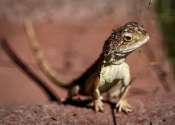Invasive species sound off about impending ecosystem changes
Anticipating changes to ecosystems is often at best an educated guess, but what if there was a way to better tune into possible changes occurring?

Anticipating changes to ecosystems is often at best an educated guess, but what if there was a way to better tune into possible changes occurring?
Plants & Animals
Apr 18, 2024
0
25

On a recent weekday, short but mighty flames began consuming an expanse of tallgrass in Illinois' Nachusa Grasslands, their advance marked with crackles and pops.
Ecology
Apr 1, 2024
0
15

Australia's grassland earless dragon is no bigger than a pinkie when it emerges from its shell, but the little lizard faces an enormous challenge in the years ahead: avoiding extinction.
Plants & Animals
Mar 27, 2024
0
169

From eye level, the wisps of green emerging from sand dunes up and down Pinellas County's barrier islands look sparse, stubby, almost tentative as they peek at the sun. Below the surface, though, they are spreading out, trapping ...
Plants & Animals
Mar 25, 2024
0
9

In a leap toward managing the ecological challenge posed by alien plant species, a recent study outlines a methodology for integrating and harmonizing data on plant invasions across Australia.
Plants & Animals
Mar 21, 2024
0
0

As the climate warms, the number of alien species on every continent is expected to increase 36% by 2050. Some alien species—that is, plants or animals that live outside their natural range—are invasive and can harm ecosystems ...
Ecology
Mar 13, 2024
0
20

Invasive plants can stay dormant for decades or even centuries after they have been introduced into an environment before rapidly expanding and wreaking ecological havoc, according to a new study led by the University of ...
Plants & Animals
Mar 6, 2024
1
73

In a study recently published in the journal Ecology, University of California, Irvine scientists uncover the intricate dance between drought, wildfires and invasive species in Southern California's coastal sage scrub ecosystems.
Plants & Animals
Feb 28, 2024
0
19

The critical role of gardeners in identifying 'future invaders'—ornamental plants that could become invasive species—has been revealed by researchers from the University of Reading and the Royal Horticultural Society.
Plants & Animals
Feb 27, 2024
0
3

There haven't been many long-term studies on urban forests, but data collected from the Thain Family Forest, which the New York Botanical Garden (NYBG) has been stewarding for more than a century, has provided an opportunity ...
Ecology
Feb 20, 2024
0
5